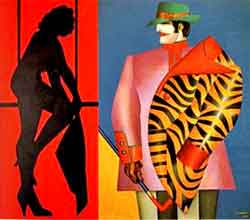Pop Art in the Heart of Havana
- Submitted by: admin
- Arts and Culture
- Culture and Traditions
- Havana
- international
- Paint and Sculpture
- personalities
- Society
- Spain
- Personalities
- 03 / 08 / 2010

Since early February the temporary hall of the Universal Art Building of the National Museum of Fine Arts (MNBA) opened its curtains for the exhibition “El Pop Art en la Colección del IVAM”, co-produced by the Valencian Institute of Modern Art (IVAM) and the State Society for External Cultural Action of Spain (SEACEX), recently visited by Cubasi.
During our tour through the sumptuous facility located among Havana’s busy boulevards of San Rafael and Obispo —right in the core of Havana— we saw numerous public, most of them young students and graduates from the different artistic education schools, who massively go the MNBA with the aim of finding and enjoying there the creations from some of the authors who amid the 1950s led an artistic movement emerged UK and supported by U.S. later, in order to finally to radiate strongly in the ‘60s, toward the rest of Europe and Latin America.
But the exhibition that occupies great part of the ground floor of MNBA’s Universal Art Building at present actually offers a scanty vision about this artistic trend created as an active reaction against the increasingly predominant influences of abstract impressionism, for which it took, as center of thematic attention, the manipulation of drawings, ads, industrial objects, comics and other symbols taken from popular culture.
The exhibition cured by Consuelo Císcar, IVAM’s director, and William Jeffet, conservator of the Salvador Dali Museum in St. Petersburg (Florida, USA), aimed at exhibiting the relationship and influence between the US and European artists who cultivated pop.
But the expectations of the observer vanish as much before the lamentable absence of signatures, as before the inclusion of minor iconographies from great authors, eminently pop representatives, such as Robert Rauschenberg, labelled by some as the Father of Pop, Claes Oldenburg, symbolized here with his weak realizations recreated in the potatoes and the huge saw handle (Saw handle, 1966) and James Rosenquist, with only one work entitled “Nails” (1973).
Luckily, visitors can recognize other famous signatures, like that of Richard Hamilton, through two of his excellent works, mainly the one entitled “Epiphany” (1987-1989), as well as Jasper Johns’s —who developed the “art-as-object” idea, Robert Rauschenberg, labelled by some as the Father of Pop, which had a strong influence in sculpture and painting later. Meanwhile, noted Equipo Crónica, which worked in Valencia between 1964 and 1981, exhibits pieces “America, America (1965) and “Guernica” (1971), this last the best work seen in this proposal.
Seen this way, “El pop art en la colección del IVAM” cannot be considered as a solid anthological approach to this movement, but as a grateful gesture from that institution to share with us its treasured up pop art collection.
Source: Cubasi
Comments